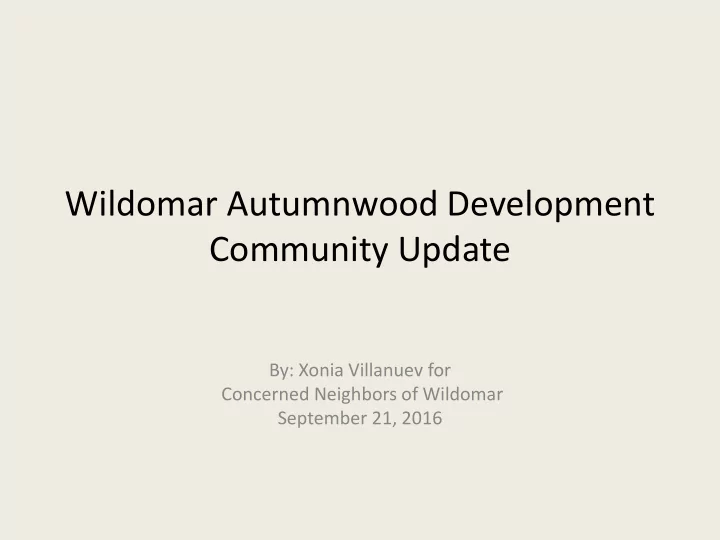

Wildomar Autumnwood Development Community Update By: Xonia Villanuev for Concerned Neighbors of Wildomar September 21, 2016
Recap: Autumnwood, a community of 61+ homes built on toxic soil - first homes completed in 2006 Riverside County approved 51K cubic • yards of “fill material” to be used for residential fill from the Rancho California Water District (RCWD)wastewater treatment pond site, excavated from an area next to two ponds that included stockpiles of dirt from the late 80’s and early 90’s (source unknown) Others sources - unpermitted “fill • material” came from the “washout areas” of Lake Elsinore and the corner of Clinton Keith & Washington Avenue in Wildomar/Murrieta Eyewitness report - dump trucks • carrying spoils from two gas station underground storage tank (UST) repair jobs from Temecula, and from an illegal auto dismantling yard in Murrieta
Something’s Wrong! • Chemical and gasoline odors • Pet deaths & illnesses • Resident deaths by pneumonia • Possessions & homes contaminated! • Residents flee homes • Mold evaluation inconclusive • Tests found toxic substances in groundwater, soil, sub slabs, and in ambient and indoor air!
Can’t BREATHE inside our HOMES
Hair Loss, Painful Blisters & Rashes
Lupus Rash, Blisters, Sores
Hives and Rashes
Our Pets Get Sick and Die
Abandoned Homes & Possessions that make your skin BURN!
DTSC Closed the Autumnwood Investigation October 2014 • DTSC maintained VOC’s detected were just too low to be of concern • DTSC prepared tables and charts of Tentatively Identified Compounds (TIC) and estimates of Total Petroleum Hydrocarbons (TPH) they also said were too low • DTSC refused to provide us QA/QC raw data reports in support of their findings
We asked EPA to review the data and DTSC’s findings… • EPA also asked DTSC to provide raw data back-up to support their findings • DTSC could not produce it • EPA asked DTSC to have the lab generate new TIC raw data report per EPA procedures
EPA found… 30 chemicals per sample compared to DTSC’s 10 chemicals per sample • Acetaldehyde (DTSC) November 2013 – in sub slab and oil gas samples • throughout the development. Some detections greater than an acute OEHHA screening level, protective for respiratory and eye irritation, including bronchoconstriction. “The predicted indoor air concentration also exceeds USEPA and OEHHA screening levels protective for long term respiratory effects, including degenerative, inflammatory, and hyperplastic effects on the respiratory system” per EPA . Acetaldehyde (SCAQMD) January 2013 – EPA found detection levels identified as a potential irritant hazard and could instigate ( acute) symptoms. SCAQMD failed to report. Acetaldehyde (Nancy Carraway) August 2012 - The tree branch had • concentrations of 47,000 ug/m3, twice the amount detected by DTSC in November 2013.
EPA also found… Acrolein (SCAQMD) January Report 2013 - EPA found in SCAQMD testing • concentrations exceeding health based screening levels and is an (acute) irritant after short term exposure. 2 out of 3 homes had these detections. SCAQMD failed to report. “Detected concentrations are more than 10-fold above the USEPA screening level protective for non-cancer hazards for long term acrolein exposures and more than 5-fold above an intermediate term screening level protective for respiratory irritant (acute) effects set by the ATSDR” Per EPA 1, 2-Dichloropropane (SCAQMD) January 2013 - EPA said SCAQMD detected • concentrations above their respective cancer risk based screening levels. SCAQMD failed to report. Vinyl Chloride (SCAQMD) January 2013 – EPA said SCAQMD detected • concentrations above their respective cancer risk based screening levels. SCAQMD reported a non-detect (ND) for Vinyl Chloride for all homes tested and verbally denied the chemical was present. Acrolein (DTSC) November 2013 – in groundwater, sub slabs nor soil gas were • tested for acrolein.
Cont… • Formaldehyde has been detected in various media throughout the development 2012; 2013; and 2014, consistently. – Formaldehyde (Nancy Carraway) 2012 & 2014 – In 2012, NC tested 4 homes indoors and 1 home outside. Formaldehyde was detected outside at levels above the CHHSLs and 3 out of 4 homes had acute levels of formaldehyde identified by OEHHA. – Formaldehyde (DTSC) 2013 – DTSC had detections in the sub slab of 3 separate homes. – Formaldehyde (Nancy Carraway) 2013 – detections at3 homes in the sub soil 3 – 5 ft deep and ambient air at 5 ft above the ground, and 10 – 25 ft. away from the homes. – Formaldehyde (DTSC) 2013 – Detected in groundwater at 12 ug/L
Moving forward We met with EPA on June 8, 2016 to discuss their findings and share information. We agreed in the meeting that next steps were to sit down with DTSC to discuss the need for further, more robust, testing since density of testing had not been conducted previously and for the following reasons: – Illnesses persist in the community – Lots of Benzene detections throughout development pose a risk for Lymphoma – Acute levels of Acetaldehyde throughout – Acute levels of Acrolein and sub slabs and soil gas not tested – Acute levels of Formaldehyde, and need for new sampling – Higher carcinogenic levels of VOCs including Vinyl Chloride which was never reported by SCAQMD to residents – Testing should be conducted next to homes not in streets!
Lack of Transparency & Importance of Raw Data • Lack of Transparency : – DTSC deviated from the Wildomar Work Plan and verbal commitment to test for all Chemicals of Concern (COC). – DTSC refused to provide quality assurance/quality control reports to support their final conclusions. Refusing to provide these reports raised questions about DTSC’s ability to be trusted • Raw Data : – Raw data should always be made available to anyone upon request because it holds agencies accountable for the integrity of their work. – If it weren’t for the raw data received we would not have been able to identify many discrepancies in the product of DTSC’s work
Recommend
More recommend